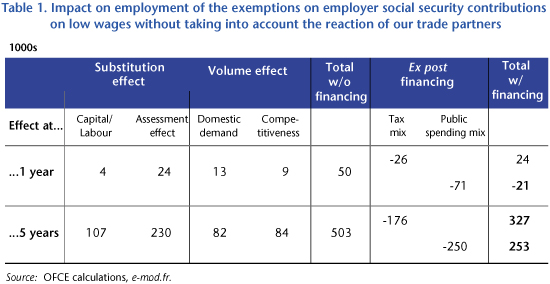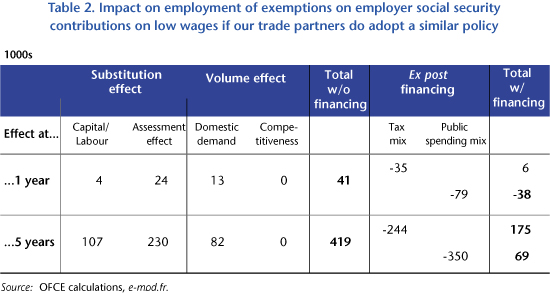By Frédéric Gannon (Université du Havre) and Vincent Touzé
On Thursday, 28 June 2012, the United States Supreme Court delivered its verdict. The principle that individuals are obliged to take out health insurance or else face a financial penalty, a central plank in the 2010 reform [1] of the health insurance system (the Affordable Care Act [2]), was held to be constitutional. This reform had been adopted in a difficult political context. It includes a variety of measures intended to significantly reduce the number of Americans without health coverage. Although it will increase federal spending, new revenues and spending cuts will make it possible to reduce the deficit.
From September 2009 to March 2010, there was a lengthy process of drafting and approving the law, with an uncertain outcome due to the lack of a majority in the Senate [3]. Since the law passed by the House of Representatives and signed on 23 March 2010 by President Obama differed from the version passed by the Senate, amendments were introduced in a Reconciliation Act that was passed on March 30th. Opponents of the reform (26 states, numerous citizens and the National Federation of Independent Business) then decided to take the fight to the US Supreme Court. Their hopes rested mainly on the possible unconstitutionality of the law, which centered on the individual’s obligation to take out health insurance, called the “individual mandate”, and on the expansion of the Medicaid public insurance program.
The favourable judgment of the Supreme Court was obtained with a narrow majority: five judges voted for [4] and four against [5]. The political inclinations of the judges did not seem to have worked against the law, since Chief Justice John G. Roberts, an appointee of George W. Bush, gave his approval. The Supreme Court majority considered that the financial penalty for a failure to take out insurance is a tax [6] and that it had no cause to rule on the merits of such a tax. It passed this responsibility to Congress (the upper and lower houses) which, in this case, has already debated and approved the law. Consequently, this point of law is valid.
According to the Supreme Court, the financial penalty for failing to purchase health insurance could be viewed as an individual obligation to purchase [7], and “the Commerce Clause does not give Congress that power”. But from a functional standpoint, this penalty can be regarded as a tax, in which case Congress has discretion to “lay and collect Taxes” (Taxing Clause). Hence the positive verdict of the Supreme Court. However, the Court believes that “the Medicaid expansion violates the Constitution” because the “threatened loss of over 10 percent of a State’s overall budget is economic dragooning that leaves the States with no real option but to acquiesce in the Medicaid expansion”.
The Supreme Court decision represents a major victory for President Barack Obama, who had made a reform to ensure more equal access to the health insurance system one of the spearheads of his 2008 election campaign. His Democratic predecessor in the White House, Bill Clinton, previously had to abandon a similar reform due to fierce opposition from the Republicans and growing divisions among the Democrats. In order to give himself every chance of success, Obama has had to be more strategic in the programming of both the reform and the way it was presented [8]. To do this, he also assembled a team of experienced specialists [9].
The Act represents a real cultural revolution in a country where the health insurance system excludes nearly 50 million people. Besides the individual mandate requiring Americans to purchase health insurance, the ACA’s main measures are:
- The creation of “exchanges” for insurance contracts where people can buy health coverage, with a government subsidy that depends on the level of income;
- Expansion of the Medicaid public health insurance program [10] (public coverage for all households with incomes below 133% of the federal poverty level) and financial penalties on states that choose not to implement this expansion (elimination of all federal funding of the Medicaid program);
- A requirement that employers offer health insurance to their employees (application of financial penalties if the obligation is not met, with exceptions for small businesses);
- New regulations on the private insurance market (obligation to offer coverage to all individuals, with no conditions on their health status).
Beginning in 2014, millions of uninsured American households should benefit from the expansion of Medicaid, which the Supreme Court has now ruled unconstitutional – this raises numerous questions [11]. How many States will be tempted not to expand Medicaid? What are the consequences for the poor households [12] who were to benefit from this expansion? Will they have the means to afford subsidized private insurance [13]? Will they be penalized financially if they do not buy insurance? Will they be encouraged to migrate to States that have adopted the expansion [14]? It is reasonable to expect that few States [15] will boycott the expansion of Medicaid, as the ACA offers them other strong incentives (federal assumption of 100% of the additional cost from 2014 to 2016, then 95% after 2017, and 90% after 2020; loss of some federal funds if no expansion). However, adjustments in the law will likely be useful if policymakers want to avoid excluding those who are too poor to afford subsidized private insurance.
The law will come into force gradually, with the various measures to apply from 2014. According to the latest report by the Congressional Budget Office (2012), annual government expenditure (expansion of Medicaid and private insurance subsidies) should rise by about $265 billion per year [16] by 2022 (the estimated total cost between 2012 and 2022 is $1,762 billion), and the number of uninsured should fall by about 33 million [17]. The reform also provides for an increase in tax revenue (higher compulsory levies and new taxes) and a reduction in federal spending (primarily substitutions between the expanded Medicaid program and the old program). This will result in amply offsetting the cost of the reform. In a previous report in March 2011, the CBO estimated that the total reduction in the deficit over the period 2012-2021 will come to $210 billion. In the name of hallowed liberties, however, there is still strong opposition to the individual mandate [18], but over time it can be hoped that this mandatory principle will come to be viewed first and foremost as a basic right that protects all citizens.
[1] For an overview of the health insurance system and the reform, see Christine Rifflart and Vincent Touzé, “La réforme du système d’assurance santé américain”, Lettre de l’OFCE, n°321, 21 June 2010. Also see the Wikipedia article on this subject.
[2] This legislation reconciles the two laws, the Patient Protection and Affordable Care Act and the Health Care and Education Reconciliation Act.
[3] “Health Care Reform: Recent Developments”, The New York Times, June 29, 2012.
[4] Stephen Breyer, Elena Kagan, Ruth Bader Ginsburg, and Sonia Sotomayor, along with Chief Judge John G. Roberts.
[5] Clarence Thomas, Anthony Kennedy, Antonin Scalia and Samuel Alito.
[6] Floyd Norris, “Justices Allow the Term ‘Tax’ to Embrace ‘Penalty’”, The New York Times, June 28, 2012.
[7] The legal position of the Obama administration has been to argue that the portion of the obligation to purchase insurance tantamount to a tax is the penalty paid by those who do not meet this requirement. This penalty has a regulatory function: it is designed based on the logic of an incentive, and not from the perspective of new tax revenue. Judge Jeffrey Sutton explained that if the government had clearly specified that the obligation to buy insurance was a tax, it would have been easier to justify in terms of its constitutionality. Most tax allowances or tax rebates are positive incentives (tax breaks on the acquisition of cleaner vehicles, for example). The health insurance requirement acts instead as a negative incentive by imposing a penalty / fine on those who decide not to buy insurance. Faced with these alternatives, they will choose in all rationality – according to a Pigouvian perspective – the option that they consider the most profitable or the least costly.
[8] Ezra Klein, “Barack Obama, Bill Clinton and Health-Care Reform”, The Washington Post, July 26, 2009.
[9] Robert Pear, “Obama Health Team Turns to Carrying Out Law”, The New York Times, April 18, 2010.
[10] Medicaid is a public health insurance program for the poorest households (about 35 million beneficiaries). The numerous criteria (income, age, degree of invalidity, state of health, etc.) lead to excluding a non-negligible portion of society’s poorest. Hence more than 20 million people living below the federal poverty level do not have access to Medicaid. On the other hand, Medicare, the other public health insurance program, which is only for those aged 65 and over, broadly covers this age group.
[11] Urban Institute-Health Policy Center, “Supreme Court Decision on the Affordable Care Act: What it Means for Medicaid”, Policy Briefs, June 28, 2012.
[12] Genevieve M. Kenney, Lisa Dubay, Stephen Zuckerman and Michael Huntress, “Making the Medicaid Expansion an ACA Option: How Many Low-Income Americans Could Remain Uninsured?”, Policy Briefs, Urban Institute – Health Policy Center, June 29, 2012.
[13] In the absence of an expansion of Medicaid, their health insurance spending will be capped at 2% of their income.
[14] This notion of voting with their feet was put forward in an article by Charles M. Tiebout (1956): “A Pure Theory of Local Expenditures”, The Journal of Political Economy, 1956, vol. 64/5, pp. 416-424.
[15] Brett Norman, “Lew: ‘Vast majority’ of states will expand Medicaid”, Politico, 1st July 2012.
[16] In 2022, 136 billion dollars will finance public health insurance for 17 million poor people (expansion of Medicaid) and 127 billion dollars will go to subsidies for the purchase of private insurance by 18 million people.
[17] In 2022, the 27 million uninsured remaining will consist of illegal immigrants (ineligible for public and private insurance programs) and those eligible for Medicaid who do not want to take out insurance as well as those ineligible for Medicaid who also do not want insurance.
[18] Susan Stamper Brown, “Time To Clean Up The Obamacare Mess”, The Western Center for Journalism, June 26, 2012.

